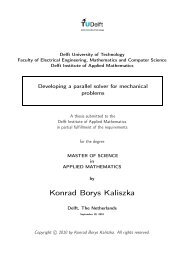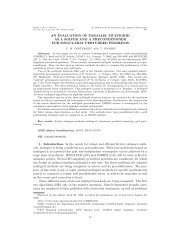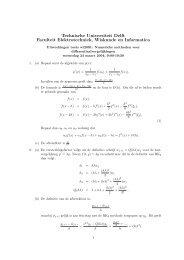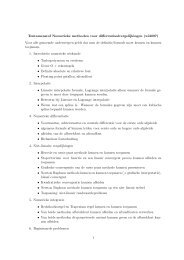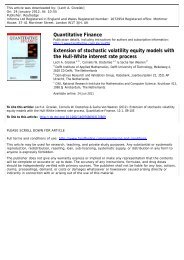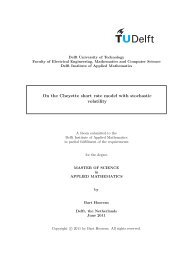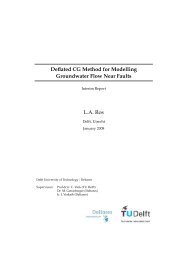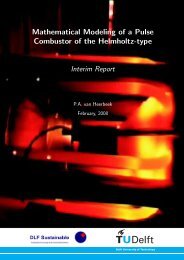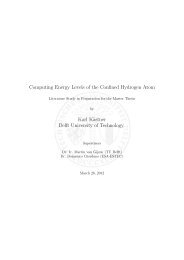Modeling bone regeneration around endosseous implants
Modeling bone regeneration around endosseous implants
Modeling bone regeneration around endosseous implants
Create successful ePaper yourself
Turn your PDF publications into a flip-book with our unique Google optimized e-Paper software.
1.4. Structure and subjects of the thesis 11is chosen, due to its sufficient simplicity and generality. First of all, theconsidered model contains diffusion and advection (taxis) terms, which areresponsible for the appearance of a wave-like profile in the solution. Suchterms are also included in similar bioregulatory models, developed by [5, 11].At the same time, the model of Moreo et al. [67] is simpler than anotherbioregulatory approach proposed by Geris et al. [40], in which angiogenesiswas represented. Mechanobioregulatory models are not mentioned here,since consideration of mechanical stimuli only complicate models and hasno added value for the present analysis.Some conditions for the formation of wave-like profiles are determinedfrom a linear stability analysis. These conditions are expressed in terms ofseveral quantitative relations for the model parameters. The linear stabilityanalysis, which is described in Chapter 2, provides some insight into thecharacteristic behavior of the bioregulatory models for <strong>bone</strong> <strong>regeneration</strong>,in which a diffusion-taxis mechanism of cell migration is incorporated.Another cellular process, which is of great importance for <strong>bone</strong> <strong>regeneration</strong>,is cell differentiation. In all continuous models, excluding the modelof Reina-Romo et al. [83], differentiation is represented by reactive terms,which correspond to immediate switch of cell phenotype. Reina-Romo et al.[83] considered the dependence of cell migration on the loading history byintroducing a maturation level of cells. The idea of a temporal transformationof cells into another phenotype is elaborated in Chapter 3, in which ageneral mathematical formalism is developed for the evolutionary cell differentiation.The considered approach can be applied to an arbitrary number ofcell types and to any set of factors influencing cell differentiation. The evolutionarymodel allows to consider a cell differentiation path, determinedby a history of mechanical and/or biochemical stimulation. The presentapproach results into a final time of differentiation, which can be importantin some applications. For instance, the boundary conditions for theperi-implant osseointegration model, which is described in Chapter 4, canbe applied, only if the time of differentiation of MSC’s into osteoblasts isfinal. An example of the application of the evolutionary approach for differentiationof MSC’s regulated by the mechanical environment, is given by asimple peri-implant osseointegration model described in Section 3.3. Numericalsimulations are carried out and results are compared with experimentaldata in Section 3.4.In Chapter 4, a new moving boundary model for <strong>bone</strong> healing <strong>around</strong><strong>endosseous</strong> <strong>implants</strong> is presented. The model is derived to accommodate thefact, that synthesis of <strong>bone</strong> within a peri-implant region occurs in the formof intramembraneous ossification [1, 14]. Davies [24] describes this processas a direct apposition of new <strong>bone</strong> matrix on a pre-existing rigid surface.The evolution of the <strong>bone</strong> forming surface (ossification front) is incorporatedin the model directly through a movement of the boundary of the soft tissueregion, which is considered as a physical domain, where various cellular



